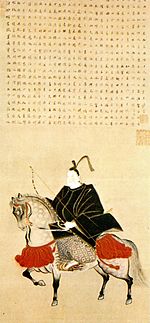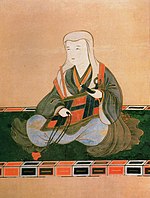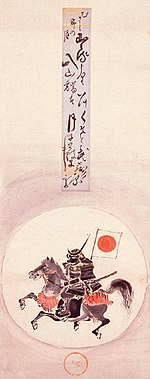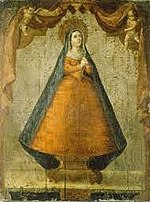Map all coordinates using OpenStreetMap
Download coordinates as:
This list is of paintings designated in the category of paintings (絵画, kaiga) for the Prefecture of Miyagi.
National Cultural Properties
As of 1 July 2019, two properties have been designated Important Cultural Properties, being of national significance.
| Property | Date | Municipality | Ownership | Comments | Image | Dimensions | Coordinates | Ref. |
|---|---|---|---|---|---|---|---|---|
| Partition paintings at Kanrantei 観瀾亭障壁画 Kanrantei shōhekiga |
early C17 | Matsushima | Kanrantei | 21 panels, colours on gold ground; paper pasted on bamboo shōji (12), hinoki fusuma (6), and the hinoki walls of the tokonoma (3); the paintings include trees, rocks, waters, and spring flowers - dandelions, daffodils, azaleas, violets, and crab apples; attributed on stylistic grounds to Kanō Sakyō (狩野左京), a painter of the Kanō School in the employ of the Sendai Domain | 38°22′10″N 141°03′41″E / 38.369437°N 141.061342°E / 38.369437; 141.061342 (Kanrantei) | |||
| Partition paintings in the Zuigan-ji Hondō 本堂障壁画 hondō shōhekiga |
1620-28 | Matsushima | Zuigan-ji | 161 panels, colours on gold ground; paintings of pines and peacocks in the Peacock Room (孔雀の間, kujaku-no-ma), of Lü Shang and King Wen in the Room of King Bun (文王の間, Bunnō-no-ma), of bamboo and plum trees, trees and flowers in the High Room and Highest Room (上段・上々段の間, jōdan-no-ma・jōjōdan-no-ma), of cherry trees in the Buddhist Room (仏間, Butsu-no-ma), of hawks and birds in the Hawk Room (鷹の間, taka-no-ma), of pines and cherry trees in the Pine Room (松の間, matsu-no-ma), and of chrysanthemums in the Chrysanthemum Room (菊の間, kiku-no-ma); the paintings are attributed to Hasegawa Tōhaku, Kanō Sakyō (狩野左京), and his pupil Kurota (九郎太); the designation includes twenty-two panels by Kibi Kōeki (吉備幸益) in the Hermit Ink Painting Room (仙人墨絵間, sennin sumie-no-ma) and twelve painted cedar doors; the paintings, dated by an ink inscription of 1730, have now been replaced with replicas and are stored in the temple museum |  |
various sizes | 38°22′20″N 141°03′35″E / 38.372213°N 141.059765°E / 38.372213; 141.059765 (Zuiganji) |
Prefectural Cultural Properties
As of 1 May 2019, fourteen properties have been designated at a prefectural level.
| Property | Date | Municipality | Ownership | Comments | Image | Dimensions | Coordinates | Ref. |
|---|---|---|---|---|---|---|---|---|
| Buddha's Parinirvāṇa 仏涅槃図 Butsu nehan-zu |
Muromachi period | Kesennuma | Hōsen-ji (峰仙寺) | colours on silk; showing the parinirvana of Shaka, the historical Buddha, underneath the sal tree, surrounded by mourners man and beast, high and low; the painting was brought from Kyōto in 1539 and since the Keichō era (1596-1615) has been remounted four times | 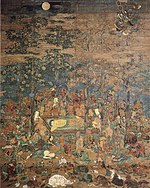 |
189.7 centimetres (6 ft 2.7 in) by 150.3 centimetres (4 ft 11.2 in) | 38°47′38″N 141°30′24″E / 38.793898°N 141.506792°E / 38.793898; 141.506792 (Hōsenji) | |
| Mandala of the Two Realms, colour on silk 絹本着色両界曼茶羅図 kenpon chakushoku ryōkai mandara-zu |
1385 | Shibata | Daikō-in (大光院) | colours on silk; remounted in 1502 and 1734 | 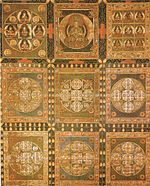  |
Diamond Realm Mandala: 157.9 centimetres (5 ft 2.2 in) by 129.7 centimetres (4 ft 3.1 in); Womb Realm Mandala: 175.1 centimetres (5 ft 8.9 in) by 129.4 centimetres (4 ft 2.9 in) | 38°04′05″N 140°45′55″E / 38.068011°N 140.765162°E / 38.068011; 140.765162 (Daikō-in) | |
| Godaidō at Matsushima 松島五大堂図 Matsushima Godaidō zu |
c.1881 | Sendai | The Miyagi Museum of Art | by Takahashi Yuichi (1828-1894); painted at the same time as his Before the Gate of the Miyagi Prefectural Office (1881); the first yōga or Western-style painting of this popular subject |  |
108.6 centimetres (3 ft 6.8 in) by 57.7 centimetres (1 ft 10.7 in) | 38°15′50″N 140°51′18″E / 38.263793°N 140.855005°E / 38.263793; 140.855005 (The Miyagi Museum of Art) | |
| Matsushima 松島図 Matsushima zu |
c.1881 | Sendai | The Miyagi Museum of Art | by Takahashi Yuichi (1828-1894); also painted at the same time as his Before the Gate of the Miyagi Prefectural Office (1881) |  |
92.5 centimetres (3 ft 0.4 in) by 47.3 centimetres (1 ft 6.6 in) | 38°15′50″N 140°51′18″E / 38.263793°N 140.855005°E / 38.263793; 140.855005 (The Miyagi Museum of Art) | |
| Before the Gate of the Miyagi Prefectural Office 宮城県庁門前図 Miyagi kenchō mon mae zu |
1881 | Sendai | The Miyagi Museum of Art | oil painting by Takahashi Yuichi (1828-1894); the building previously functioned as the Yōkendō (養賢堂) han school and was destroyed by fire in July 1945; the painting was commissioned by Miyagi Prefecture at the same time as two landscape paintings of Matsushima |  |
122.0 centimetres (4 ft 0 in) by 61.1 centimetres (2 ft 0.1 in) | 38°15′50″N 140°51′18″E / 38.263793°N 140.855005°E / 38.263793; 140.855005 (The Miyagi Museum of Art) | |
| Seikai Mandala 清海曼茶羅図 Seikai mandala zu |
Muromachi period | Sendai | Jōkaku-ji (成覚寺) | the Seikai Mandala, along with the Taima Mandala and the Chikō Mandala, is one of the three Pure Land Mandalas (浄土三曼荼羅, jōdo sanmandara); based on the Amitayurdhyana Sutra, it depicts a vision of the Pure Land granted to the monk Seikai (清海) in 996; the painting was brought from Hōrin-ji (法林寺) in Kyōto in 1630 | 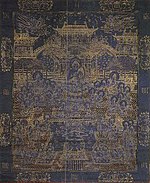 |
183 centimetres (6 ft 0 in) by 151 centimetres (4 ft 11 in) | 38°15′18″N 140°53′21″E / 38.255066°N 140.889144°E / 38.255066; 140.889144 (Jōkakuji) | |
| Sakyamunī with Sixteen Benevolent Deities 釈迦十六善神像図 Shaka jūroku zenjin zō zu |
Muromachi period | Kesennuma | Hōsen-ji (峰仙寺) | colours on silk, with kirikane, gold paint, cinnabar, yellow ochre, ultramarine, verdigris, and black ink; the Sixteen Benevolent Deities, protectors of the Mahaprajnaparamita Sutra, appear eight on each side of Shaka and the attendant bodhisattvas Fugen Bosatsu and Monju Bosatsu; the painting was brought from Kyōto in 1539 |  |
126.1 centimetres (4 ft 1.6 in) by 61.4 centimetres (2 ft 0.2 in) | 38°47′38″N 141°30′24″E / 38.793898°N 141.506792°E / 38.793898; 141.506792 (Hōsenji) | |
| Buddha's Parinirvāṇa 仏涅槃図 Butsu nehan zu |
Muromachi period | Matsushima | Zuigan-ji | colours on silk; traditionally attributed by the temple to Kanō Motonobu | 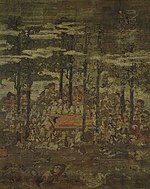 |
227 centimetres (7 ft 5 in) by 183 centimetres (6 ft 0 in) | 38°22′20″N 141°03′35″E / 38.372213°N 141.059765°E / 38.372213; 141.059765 (Zuiganji) | |
| Sakyamunī Preaching 釈迦説法図 Shaka seppō zu |
Muromachi period | Matsushima | Zuigan-ji | colours on silk | 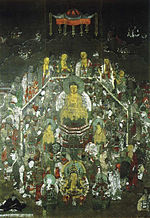 |
159.8 centimetres (5 ft 2.9 in) by 113 centimetres (3 ft 8 in) | 38°22′20″N 141°03′35″E / 38.372213°N 141.059765°E / 38.372213; 141.059765 (Zuiganji) | |
| Shōsai Hōshin 性西法身像 Shōsai Hōshin zō |
late Kamakura or early Muromachi period | Matsushima | Zuigan-ji | colours on silk; refounder of the Heian-period temple of Enpukuzen-ji (円福禅寺) as Zuigan-ji | 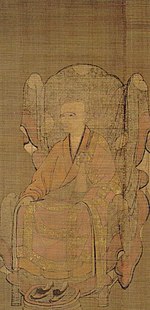 |
101 centimetres (3 ft 4 in) by 49.5 centimetres (1 ft 7.5 in) | 38°22′20″N 141°03′35″E / 38.372213°N 141.059765°E / 38.372213; 141.059765 (Zuiganji) | |
| Rankei Dōryū 蘭渓道隆像 Rankei Dōryū zō |
late Kamakura or early Muromachi period | Matsushima | Zuigan-ji | colours on silk; second chief priest of Zuigan-ji |  |
101 centimetres (3 ft 4 in) by 49.5 centimetres (1 ft 7.5 in) | 38°22′20″N 141°03′35″E / 38.372213°N 141.059765°E / 38.372213; 141.059765 (Zuiganji) | |
| Minki Sōgu 明極聰愚像 Minki Sōgu zō |
late Kamakura or early Muromachi period | Matsushima | Zuigan-ji | colours on silk; tenth chief priest of Zuigan-ji |  |
93.5 centimetres (3 ft 0.8 in) by 45.3 centimetres (1 ft 5.8 in) | 38°22′20″N 141°03′35″E / 38.372213°N 141.059765°E / 38.372213; 141.059765 (Zuiganji) | |
| Partition painting of phoenixes from the Honmaru great hall of Sendai Castle 仙台城本丸大広間障壁画鳳凰図 Sendai-jō honmaru dai-hiroma shōhekiga hōō zu |
Momoyama period | Matsushima | Matsushima Town (kept at the Kanrantei Matsushima Museum) |
colours on paper with gold ground; by an artist of the Kanō school for Date Masamune |  |
3.19 metres (10 ft 6 in) by 1.606 metres (5 ft 3.2 in) | 38°22′52″N 141°04′08″E / 38.381162°N 141.068916°E / 38.381162; 141.068916 (Matsushima) | |
| Partition painting of fans from the Honmaru great hall of Sendai Castle 仙台城本丸大広間障壁画鳳凰図 Sendai-jō honmaru dai-hiroma shōhekiga senmen zu |
Momoyama period | Sendai | Sendai City Museum | colours on paper; the fans depict subjects including a bridge and waterwheel, Musashino (武蔵野), Hamamatsu, wisteria with running water, and phoenixes with paulownias; few partition paintings survive from castles, so these are of particular significance |  |
3.30 metres (10 ft 10 in) by 1.585 metres (5 ft 2.4 in) | 38°15′21″N 140°51′24″E / 38.255891°N 140.856721°E / 38.255891; 140.856721 (Sendai City Museum) |
Municipal Cultural Properties
Properties designated at a municipal level include:
| Cultural Properties of Japan - paintings | ||
|---|---|---|
| Hokkaidō |  | |
| Tōhoku | ||
| Kantō | ||
| Chūbu | ||
| Kansai | ||
| Chūgoku | ||
| Shikoku | ||
| Kyūshū | ||
| Okinawa | ||
See also
- Cultural Properties of Japan
- List of National Treasures of Japan (paintings)
- Japanese painting
- List of Historic Sites of Japan (Miyagi)
- List of Cultural Properties of Japan - historical materials (Miyagi)
- Tōhoku History Museum
References
- "Cultural Properties for Future Generations". Agency for Cultural Affairs. Retrieved 13 August 2019.
- 国宝・重要文化財 [Number of National Treasures and Important Cultural Properties by Prefecture] (in Japanese). Agency for Cultural Affairs. 1 July 2019. Retrieved 13 August 2019.
- "Database of National Cultural Properties: 国宝・重要文化財(美術品)(絵画 宮城県)" (in Japanese). Agency for Cultural Affairs. Archived from the original on 2 May 2017. Retrieved 13 August 2019.
- ^ 文化財の種類と宮城県内の指定件数 [Number of Cultural Properties in Miyagi Prefecture] (in Japanese). Miyagi Prefecture. 15 February 2019. Retrieved 12 August 2019.
- 観瀾亭障壁画 [Partition paintings at Kanrantei] (in Japanese). Miyagi Prefecture. Archived from the original on 6 September 2012. Retrieved 5 October 2013.
- 瑞巌寺本堂障壁画 [Partition paintings in the Zuiganji Hondō] (in Japanese). Miyagi Prefecture. Archived from the original on 5 October 2013. Retrieved 5 October 2013.
- 都道府県別指定等文化財件数(都道府県分) [Number of Prefectural Cultural Properties by Prefecture] (in Japanese). Agency for Cultural Affairs. 1 May 2019. Retrieved 12 August 2019.
- ^ "Nehan-zu". Japanese Architecture and Art Net Users System. Retrieved 5 October 2013.
- "Seikai mandara". Japanese Architecture and Art Net Users System. Retrieved 5 October 2013.
- "Jōdo sanmandara". Japanese Architecture and Art Net Users System. Retrieved 5 October 2013.
- "Juuroku zenshin". Japanese Architecture and Art Net Users System. Retrieved 5 October 2013.
- 仙台市の文化財一覧 [List of Cultural Properties of Sendai City] (PDF). Sendai City. 1 April 2019. Retrieved 12 August 2019.
External links
- (in Japanese) Cultural Properties in Miyagi Prefecture
